WarioWare, Inc.: Mega Microgame$!
| WarioWare, Inc.: Mega Microgame$! |
|---|
|
Also known as: Made in Wario (JP), Wario Ware, Inc.: Minigame Mania (EU), Wario Ware, Inc. (US/EU title screen), Waliou Zhizao (CN)
|
WarioWare, Inc.: Mega Microgame$! is the gripping tale of Wario and his friends forming their own game company. The result is a bizarre collection of very short (and often very strange) minigames called "Microgames", with a few "Wario" takes on other classic games thrown in for good measure.
Appropriately for Wario, he starts off his new career by stealing from someone else - the whole concept was originally a minigame in Mario Artist Polygon Studio, with several of its Microgames (plus the boombox and music!) being refined here.
Amusingly, given that this was the first WarioWare game and WarioWare's first game, there's a bunch of unused stuff. How wonderfully meta.
Contents
Sub-Pages
| Prototype Info |
| Notes |
| Unused Graphics Various unused graphics, including a nude Wario! wait... (NSFW) |
| Development Text m_BGM_BOMB_Demo_AFRO_0 and a ton of other file names. |
| Version Differences Several differences exist between regions. |
Unused (Micro)games
| To do: Make a list of all the microgames that can be accessed in this method. |
With a cheating device or a cheat option in an emulator, change address 03000E61 to one of the following game numbers.
All of the unused games were translated to Chinese in the iQue version (including Ping-Pong VS' title screen), suggesting that whoever was responsible for localization didn't know what was actually used or unused.
Block Fever
Game Number: 2F
Internal name: BLOCK
A microgame where only two blocks can be broken before time expires. The paddle gets smaller with each level.
This was likely meant for 9-Volt's stage, as it is based on the early Nintendo arcade game Block Fever. The music that plays here is m_BGM_BOMB_02, the same as Crazy Cars, Picture Perfect, and I Spy.
F1 Race
Game Number: 5E
Internal name: F1 RACE
A microgame with all three level variations present. This was also likely meant for 9-Volt's stage as it is based on F1 Race, an early Famicom game. The stats at the top of the screen never change. The music that plays here is m_BGM_BOMB_11, the same as Munch a Bunch, Fruit Shoot, Classic Clash I, Classic Clash II, Coconut Catapult, and Classic Clash III.
Level 1 is merely a straight course.
Level 2 begins with a straight path, but curves halfway through.
Level 3 starts on a curve, and becomes straight near the end.
Color TV-Game 6
Game Number: 66
Internal name: TV GAME 6
A microgame with all three level variations. This was also likely meant for 9-Volt's stage, as it is based on Nintendo's late-1970s "Color TV Game 6" home console. The music that plays here is m_BGM_BOMB_75, the same as Stack-Up.
A similar microgame would later appear in WarioWare: Smooth Moves.
Level 2 has smaller paddles.
Level 3 has a pair of parallel paddles for each side.
VS Ping-Pong
Game Number: E5
Internal name: LP. PONG FOR TWO
A game presumably meant to be unlocked with the other VS titles. A similar concept was later used in WarioWare: Touched! as a souvenir, but with a different name (Pong-Ping) and design. The music that plays here is m_BGM_VS_PON2_10, which ended up being used for the VS Dong Dong minigame.
First to get five points wins. Like the other VS games, L and R move the paddles up and down for their respective sides.
Removed (Micro)games
In addition to the unused microgames that still have coding left, there are some minigames that do not have any coding left, instead they all point to the minigame coding for Crazy Cars, which is microgame ID 00:
| ID | Internal Name | Notes |
|---|---|---|
| 7 | KILL VIRUSES | This would have played the track m_BGM_BOMB_09, the same as Hare Scare, Go Fer the Tater, Veggie Might, and Mashin' Martians. |
| 34 | FROG JUMP ( DUMMY ) | Comes after the used minigame with ID 33 Hoppin' Mad which it would have most likely been related to, as that microgame has the internal name FROG SWIM. This would have played the track m_BGM_BOMB_20, the same as Manic Mechanic, Guy Scraper, Lift & Shout, Laser Outlaw, and Super Fly. |
| 53 | SUPER MARIO? BASEMENT | Would have been a variant of Super Wario Bros., as that minigame has the internal name SUPER MARIO?. "Basement" implies that it may have been an underground variant. It is assigned the unused track m_BGM_BOMB_25. |
| d8 | LP. STREET FIGHT | The LP. prefix is used for the boss minigames and unlockable minigames such as Dr. Wario. Its positioning between the Ultra Machine and Punch Out boss minigames hints that it would have been a boss minigame too, and the name appears to indicate that it would have been a fighting game in the vein of Street Fighter. Usually, the field for the music track is blank for boss/unlockable minigames (and handled in the game's function code instead), but this entry points to the track m_x_BGM_BOMB_2bar, the same as Boom Box, City Surfer, Raaaarrrrggghh, and Leafy Greens. |
| de | LP. GOMA ( Dummy ) | The LP. prefix is used for the boss minigames and unlockable minigames such as Dr. Wario. Its positioning between the Dungeon Dilema and The Frog Flap boss minigames hints that it would have been a boss minigame too. Like the other boss/unlockable minigames, there is no music pointer in this entry, however there are two unused associated sounds with GOMA in their filenames: s_BOMB_BOSS_Goma_FALL_0 and s_BOMB_BOSS_Goma_FALL_9. |
| de | LP. ROBO CONTROL | An unused VS minigame. Its music entry is blank like the other VS minigames, but it most likely would have played the unused music track m_BGM_VS_RoboControl_10. |
| ef | LP. FUNCTION TEST | The LP. prefix is used for the boss minigames and unlockable minigames such as Dr. Wario. Usually the field for the music track is blank for boss/unlockable minigames (and handled in the game's function code instead), but these entries point to the track m_x_BGM_BOMB_2bar, the same as Boom Box, City Surfer, Raaaarrrrggghh, and Leafy Greens. |
| f0 | LP. 3D TEST |
Unused Microgame Variants
The following Orbulon microgames have unused variants with different music and that are 2 bars long, instead of the usual 4 bars:
| ID | Internal Name | Final ID | Final Name | Microgame Name | Notes |
|---|---|---|---|---|---|
| 1a | LET'S DANCING | ca | L. DANCE | Getcha Groove On | This microgame cannot be completed because the inputs for this game are usually taken after 2 bars have passed. The music that would have been played here is m_BGM_BOMB_02, the same as Crazy Cars, Picture Perfect, and I Spy. |
| 1e | CUP NOODLE | bf | L. CUP NOODLE | Noodle Cup | The music that would have been played here is m_BGM_BOMB_08, the same as Dodge Balls, Zero to Hero, Pro Curling, Ring My Bell, The Maze That Pays, Mouse Trap, and Alien Ambush. |
| 22 | EXCEPTION | c0 | L. EXCEPTION | Odd Man Out | The music that would have been played here is m_BGM_BOMB_02, the same as Crazy Cars, Picture Perfect, and I Spy. |
| 3d | PRAISE or ABUSE | d4 | L. PRAISE or ABUSE | Praise or Haze II | |
| 41 | ENTER COMMAND | d5 | L. ENTER COMMAND | Code Buster | The music that would have been played here is m_BGM_BOMB_05, the same as Space Escape, and UFO ASSIST. |
Unused Dodge Balls Levels
Dodge Balls retains the higher level capabilities present in the demo from Wario World, including the unused Level 7, Level 8, and Level 9. Munch a Bunch and Repellion, on the other hand, have their coding changed and cannot support Levels 4-7 and Levels 4-10 respectively.
Leftover Minigame Debug Functionality
There are three minigames that have leftover byte fields that, when set to a non-zero value, will ignore the collision check if the R button is held. They cannot be seen in normal gameplay as those fields are always initialized with the value 0.
Paper Plane
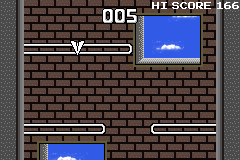
When the byte is set to a non-zero value and R is held, the paper plane will be able to pass through any obstacles. This functionality does not have a leftover equivalent in the microgame version of Paper Plane or in the DSi version of this minigame.
To restore this debug function, change the bytes 80 18 04 70 to 01 22 02 70 at the following ROM locations:
| Japanese | American | European | Chinese |
|---|---|---|---|
| e2178 | e2748 | e2e50 | e32b8 |
Jump Forever
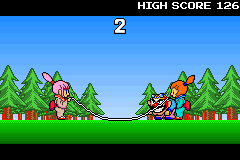
When the byte is set to a non-zero value and R is held, Wario will be completely unaffected by the rope. When R is held, Wario cannot walk past the characters holding the rope, however they are able to walk past him - when this happens, Wario's position is reset when he moves again. A side effect of holding R is that the "wind" sound effect that usually plays when the rope is at its peak will not play, as it is in the same function as the collision which gets skipped over when R is pressed. Jumpin' Rope, the microgame version of this minigame, does not have an equivalent leftover.
To restore this debug function, change the bytes C2 30 04 70 to 01 22 42 70 at the following ROM locations:
| Japanese | American | European | Chinese |
|---|---|---|---|
| d9f6c | da52c | dac04 | db06c |
Skating Board
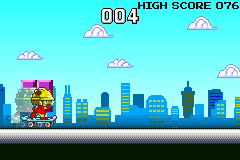
When the byte is set to a non-zero value and R is held, 9-Volt will be able to go past the obstacles and birds. There is no leftover equivalent to this functionality in City Surfer, the microgame version of this minigame.
To restore this debug function, change the bytes 80 18 04 70 to 01 22 02 70 at the following ROM locations:
| Japanese | American | European | Chinese |
|---|---|---|---|
| e6516 | e6ae6 | e724a | e76b2 |
Unused Language Selection Menu
| North American | European |
|---|---|
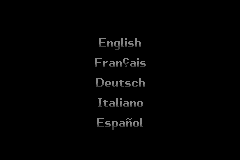 |
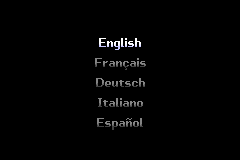 |
The North American has the language selection menu that is partially implemented, but is completely unused as that version can only be played in English. The initialization function for this screen remains however the main function has been removed (possibly commented out). As a result, all 5 languages remain greyed out, cannot be selected, are animated simultaneously (instead of just the selected option) and the game is soft locked as no inputs are read at all when this mode is triggered. Another difference is that the cedilla (ç) in the word "Français" is positioned differently, where it is higher.
The Chinese version also has this menu, however unlike the North American version, the screen is completely blank as the game does not load any visible tiles for the letters. The game however still renders OAM sprites for the letters. On the other hand, this language selection screen has not yet been implemented for the Japanese version.
By replacing the byte 05 with 07 at the following ROM locations, the language selection screen can be loaded instead of the intro animation:
| North American | Chinese |
|---|---|
| db42 | e062 |
Unused Audio
To do:
|
| Filename | Music | Notes |
|---|---|---|
| x_TEST | A dummy sound which plays if the sound being referenced does not exist. | |
| m_x_BGM_BOMB_4bar | Two test tracks for the different length microgames. 4 bars is the length of Orbulon's microgames, while 8 bars is twice as long. While there is test music for 2 bars, it is used for a couple of microgames. | |
| m_x_BGM_BOMB_8bar | ||
| m_BGM_01 | Music track of unknown purpose. This track was replaced with a MIDI file with no note data in the European and Chinese versions with the first MIDI track name's set to "EUROPE_NoMidi". | |
| m_BGM_Title_01 | The title music played at microgame speed. The title screen does not last long enough to reach the loop, so part of this track cannot be heard normally. The rest of this track would be heard in the credits medley used in Mega Party Game$. | |
| m_BGM_BOMB_Demo_AFRO_NEXT2A | Alternate versions of Jimmy answering his phone. | |
| m_BGM_BOMB_Demo_AFRO_NEXT2B | ||
| m_BGM_BOMB_Demo_AFRO_NEXT2C | ||
| m_BGM_DraBuru_02_IN | Tune for retrying from between the first and second bosses of Dribble. | |
| m_BGM_DraBuru_03_IN | Tune for retrying from between the second and third bosses of Dribble. | |
| m_BGM_DraBuru_04_IN | Tune for retrying from between the third and fourth bosses of Dribble. | |
| m_BGM_DraBuru_02_END | Music for losing between the first and second bosses of Dribble. | |
| m_BGM_DraBuru_02_BOSS_IN | Tune intended to be used before the second boss of Dribble and can be heard by making the stage go fast enough (via TAS). | |
| m_BGM_DraBuru_03_END | Music for losing between the second and third bosses of Dribble. | |
| m_BGM_DraBuru_03_BOSS_IN | Tune intended to be used before the third boss of Dribble and can be heard by making the stage go fast enough (via TAS). | |
| m_BGM_DraBuru_03_SpeedUp | Tune intended for speed up between the second and third bosses of Dribble. | |
| m_BGM_DraBuru_04_Intro | Tune intended to be used after the third rest of Dribble. | |
| m_BGM_DraBuru_04_END | Music intended for losing between the third and fourth bosses of Dribble. | |
| m_BGM_DraBuru_04_BOSS_IN | Tune intended to be used before the fourth boss of Dribble and can be heard by making the stage go fast enough (via TAS). | |
| m_BGM_DraBuru_04_SpeedUp | Tune intended for speed up between the third and fourth bosses of Dribble. | |
| m_BGM_Loo_Game_1_7 | The final two parts of the background music for Dr. Crygor. These are never reached because the background music restarts after every speed up and boss, the latter of which begins before m_BGM_Loo_1_6 can finish. | |
| m_BGM_Loo_Game_1_8 | ||
| s_Demo_Title_BUMP | Sound of unknown purpose. | |
| s_BOMB_BOSS_Goma_FALL_0 | Sounds for the missing boss "LP. GOMA ( Dummy )". Both sound similar to s_BOMB_BOSS_Nail_FALL_0, which is the jingle that plays in the beginning of Mona's boss microgame Nail Call. | |
| s_BOMB_BOSS_Goma_FALL_9 | ||
| s_BOMB_JUMP_12 | Assorted microgame sound effects. | |
| s_BOMB_Bound_07 | ||
| s_BOMB_Count_01 | ||
| s_BOMB_CURSOR_01 | ||
| s_BOMB_CAR_03 | ||
| s_BOMB_BUMP_03 | ||
| s_BOMB_Beat_Tel_03 | ||
| s_BOMB_Mario2_Step_ON_1 | Sounds for a second Super Mario Bros. microgame. | |
| s_BOMB_Mario2_Step_ON_2 | ||
| s_BOMB_Mario2_Step_ON_3 | ||
| s_BOMB_Mario_Step_ON_END2 | ||
| s_Drum_BD_1 | Sounds for some kind of drum set. | |
| s_Drum_SD_1 | ||
| s_Drum_SD_Rim_Close | ||
| s_Drum_SD_Rim_Open | ||
| s_Drum_SD_Roll | ||
| s_Drum_Tom_1 | ||
| s_Drum_Sym_Crash | ||
| s_Drum_Sym_Sprash | ||
| m_BGM_BOMB_06 | Music for a 2-bar microgame. | |
| m_BGM_BOMB_16 | Music for a 2-bar microgame that has to do with a train. | |
| m_BGM_BOMB_22 | Possibly intended to be an alternative track for Gold Digger. | |
| m_BGM_BOMB_25 | Music that is assigned to the removed "SUPER MARIO? BASEMENT" microgame. It's the first few notes of the main Super Mario Bros. theme, using both male and female voices. m_BGM_BOMB_23, the used music for Super Wario Bros., has those same notes of the main Mario theme but with a barking sample instead. | |
| m_BGM_BOMB_32_Wario_01 | Three tracks for a 2-bar Wario Land microgame. The main melody comes from the first game, and the first track sounds very similar to the music of that game. The third track uses musical elements from the fourth game, while the second track uses some techno-ish sounds that don't really fit with much of anything else in this game.
Wario Land microgames would eventually appear in WarioWare: Smooth Moves, WarioWare: D.I.Y. Showcase, and WarioWare Gold based on Wario Land: Super Mario Land 3, Wario Land 4, and Wario Land 3 respectively. | |
| m_BGM_BOMB_33_Wario_02 | ||
| m_BGM_BOMB_34_Wario_03 | ||
| m_BGM_BOMB_45 | Duplicates of the microgame music for Tip the Scale. | |
| m_BGM_BOMB_47 | ||
| m_BGM_BOMB_86 | Possibly an alternative track for Right in the Eye. | |
| m_BGM_BOMB_Demo_2 | Music track of unknown purpose. The only thing named similarly is m_BGM_BOMB_Demo_11, the speed up tune for Introduction, although this has more to do with the main menu theme than it does that. | |
| m_BGM_VS_RoboControl_10 | Music intended to be used for the unused LP. ROBO CONTRO minigame. Uses voice samples from Four Seasons. | |
| s_VS_PON_Power_1 | Sounds intended for the unused VS minigame Ping-Pong. | |
| s_VS_PON_Power_2 | ||
| s_VS_Push_HIT_01 | Sound intended for the VS minigame Dong Dong. | |
| s_v_WARIO_WIN_YOKI | Wario saying "Yahoo!", more drawn-out than heard in-game. Like all of his other voice sequences, this is recycled from Wario Land 4. | |
| s_v_App_Morning_1 | Jimmy saying "Good morning." | |
| s_v_App_Hello_1 | Jimmy saying "Hello?", as heard in Level 3 of Cymbalism. | |
| s_v_App_Night_1 | Jimmy saying "Good night." Later used in WarioWare: Twisted! for Staying Asheep. |
The Wario series
| |
|---|---|
| Wario Land | |
| Game Boy (Color) | Wario Land: Super Mario Land 3 • Wario Land II • Wario Land 3 |
| Game Boy Advance | Wario Land 4 |
| GameCube | Wario World |
| Nintendo DS | Wario: Master of Disguise |
| Wii | Wario Land: Shake It! |
| WarioWare Inc. | |
| Game Boy Advance | Mega Microgame$! (Demos) • Twisted! |
| GameCube | Mega Party Game$! |
| Nintendo DS | Touched! (Demo) • D.I.Y. |
| Nintendo DSi | Bird & Beans • Paper Airplane Chase (iQue Prototypes) |
| Wii | Smooth Moves • D.I.Y. Showcase |
| Wii U | Game & Wario |
| Nintendo 3DS | WarioWare Gold |
| Nintendo Switch | Get It Together! • Move It! |
| Miscellaneous | |
| NES | Wario's Woods |
| SNES | Mario & Wario • Wario's Woods |
| Game Boy (Color) | Wario Blast: Featuring Bomberman! |
| See Also | |
| Mario • Rhythm Heaven | |
- Pages missing developer references
- Games developed by Nintendo R&D1
- Pages missing publisher references
- Games published by Nintendo
- Games published by iQue
- Game Boy Advance games
- Pages missing date references
- Games released in 2003
- Games released in March
- Games released on March 21
- Games released in May
- Games released on May 21
- Games released on May 23
- Games released in June
- Games released on June 6
- Games with unused areas
- Games with hidden development-related text
- Games with unused game types
- Games with unused graphics
- Games with unused music
- Games with unused sounds
- Games with regional differences
- To do
- Wario series
Cleanup > Pages missing date references
Cleanup > Pages missing developer references
Cleanup > Pages missing publisher references
Cleanup > To do
Games > Games by content > Games with hidden development-related text
Games > Games by content > Games with regional differences
Games > Games by content > Games with unused areas
Games > Games by content > Games with unused game types
Games > Games by content > Games with unused graphics
Games > Games by content > Games with unused music
Games > Games by content > Games with unused sounds
Games > Games by developer > Games developed by Nintendo > Games developed by Nintendo EPD > Games developed by Nintendo SPD > Games developed by Nintendo R&D1
Games > Games by platform > Game Boy Advance games
Games > Games by publisher > Games published by Nintendo
Games > Games by publisher > Games published by Nintendo > Games published by iQue
Games > Games by release date > Games released in 2003
Games > Games by release date > Games released in June
Games > Games by release date > Games released in June > Games released on June 6
Games > Games by release date > Games released in March
Games > Games by release date > Games released in March > Games released on March 21
Games > Games by release date > Games released in May
Games > Games by release date > Games released in May > Games released on May 21
Games > Games by release date > Games released in May > Games released on May 23
Games > Games by series > Wario series










